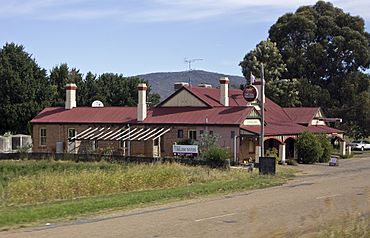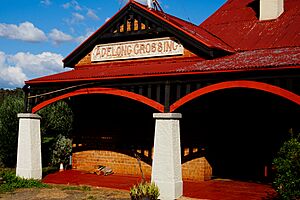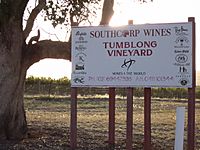Tumblong, New South Wales facts for kids
Quick facts for kids TumblongNew South Wales |
|
|---|---|

Tumblong Tavern
|
|
| Population | 338 (2011 census) |
| Postcode(s) | 2729 |
| Elevation | 303 m (994 ft) |
| Location | |
| LGA(s) | Gundagai Council |
| County | Wynyard |
| State electorate(s) | Cootamundra |
| Federal Division(s) | Riverina |
Tumblong is a small village in the central east part of a region in Australia called the Riverina. It's located about 18 kilometers (11 miles) southeast of Mundarlo and 25 kilometers (15 miles) northwest of Adelong. Until 1913, it was known as Adelong Crossing or Adelong Crossing Place. In 2011, Tumblong and the areas around it had a population of 338 people.
Contents
A Look Back at Tumblong
The land where Tumblong is today traditionally belongs to the Wiradjuri people, who are the original inhabitants of this area.
Early Days and First Settlers
Around 1831, a man named Robert Pitt Jenkins, who came from a rich family, claimed this land. He called his large property "Bangus" Station. It was about 25,000 acres (10,000 hectares). Like many landowners back then, he probably had someone else manage the property for him.
Jenkins built a big 10-room house on Bangus. In 1848, he moved his family there. He also worked as a local judge, called a magistrate, in Gundagai until 1853. After that, he moved away to his mother's estate.
From Home to Hotel
When Jenkins left, he couldn't sell his property and the 3,000 sheep he owned. So, he rented out his house, and it became a public house, which is like an inn or a hotel, called the Bangus Inn. In 1856, he finally sold the inn and a small piece of land.
The new owner of the Bangus Inn renamed it the Home Hotel. Later, in the 1870s, William Williams bought the property. He built a new hotel called the Coach and Horses in 1873. This building was replaced in 1905 by the Adelong Crossing Hotel, which is now known as the Tumblong Tavern.
A Family's Sad Story
In 1859, Robert Pitt Jenkins, his wife, and their four sons were on a ship called the Royal Charter. Sadly, the ship sank off the coast of England. They were going to visit their daughter, Alice, who was at school in Paris. Alice later inherited the Bangus property. Her husband sold it to help pay for his vineyards in another part of Australia.
The Old Flour Mill
In 1874, a flour mill opened at Adelong Crossing. It was called the Victoria Flour Mill and was owned by William Williams. It didn't do very well and only worked sometimes until about 1880. The building was still standing in 1910, but it wasn't being used.
Changing Names and Transport
In 1913, Adelong Crossing Place was officially renamed Tumblong. This was done to avoid confusion with the nearby town of Adelong. The name "Tumblong" came from a neighboring property that had been named Tumblong by its owner, Henry Stuckey.
The railway station at Adelong Crossing opened in 1903. It was also renamed Tumblong in 1913. The station had a platform and a special track for loading animals. The railway line itself closed in 1984, and the station closed in 1975.
School and Post Office
The Adelong Crossing school started as a small provisional school in 1869. It became a public school in 1870 and was renamed Tumblong in 1913. The school closed its doors in 1990. The Adelong Crossing Place Post Office opened on August 1, 1864. It was renamed Tumblong on April 15, 1913, and closed on November 30, 1973.
Tumblong Today
Today, Tumblong is a small community. It has a wrecking yard (where old cars are taken apart for parts), a few houses on the road to Adelong, and a pub. This pub is one of the few remaining directly on a part of the Hume Highway, which is a major road. Another pub like this is in Coolac.
The area around Tumblong is also home to a large vineyard. A vineyard is a place where grapes are grown to make wine. This vineyard is part of the Southcorp Wines group, which owns famous Australian wine brands like Penfolds and Lindemans. The vineyard is called Tumblong Vineyard and is located on the road between Tumblong and Mundarlo.




